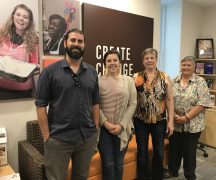By DAVID DUPONT
BG Independent News
Phil Stinson, Bowling Green State University professor in criminal justice, was in Washington D.C. working on a confidential project for the U.S. Justice Department.
A leading expert in policing he spent his days in a windowless room. Still the news about two more killings of black men by police officers penetrated the meeting room. And then late Thursday, the news broke of five Dallas police officers gunned down by a sniper. The incident, which occurred at the conclusion of a peaceful protest, ended with the gunman dead after a standoff with the police.
Was Stinson shocked by this? “Everything is business as usual,” he said. And that’s not good. “Everything’s the same. We’re in a powder keg situation. … It’s a mess and the hot summer doesn’t help.”
With the advent of social media “we’ve reached a tipping point,” Stinson said.
That was clear with the shooting of Michael Brown, a black teenager, by a white police officer, Darren Wilson, in Ferguson, Missouri. It continued with a steady stream of incidents, including the death of Alton Sterling in Baton Rouge, Louisiana, on Monday, and then the killing of Philando Castile in a Minneapolis suburb.
While videos may document these incidents, Stinson said, they don’t provide a solution.
“I honestly think the police in many parts of the country, especially urban areas … are engaged in combat policing,” he said. “They’ve come to think over time that they are dealing with people who are the enemy. They certainly treat black males as if they were the enemy. That’s a huge problem. Not only is there a fear of crime, but there’s a fear of black people.”
These officers come into a traffic stop like the one in Minneapolis or the encounter like the one in Baton Rouge, “all amped up.”
The way Alton Sterling was body-slammed shows that. “They wouldn’t do that to you or me. It’s just nuts.”
Stinson added: “You can’t shoot police officers. We can’t have that.”
He saw that in a Facebook post from a former student now in law enforcement in Texas. “He was posting this vile stuff,” Stinson said. “He should not go to work. He’s all fired up and angry. That’s not good when we already have people on edge thinking they’re going to be blown away.”
Stinson also senses a lack of leadership in the civil rights movement, and the need for the kind of creative non-violence used in the 1960s. Violence is only going to deflect attention from the root causes, he said.
Part of the problem has been the lack of reliable numbers about how many people are killed by police every year. Stinson said that he’s cobbled together numbers from the Center for Disease Control and the Justice Department, and for the past 18 months the Washington Post has been collecting a database of such deaths.
The news organization’s findings are “consistent with what I always thought,” he said. “People are killed by police about 1,000 times a year.”
Stinson continued: “That’s 2.7 a day. That’s a lot of people. … It may well be as prosecutors and investigators say that almost every one is legally justified, but there’s something wrong in this country when police are killing a 1,000 people a year. I’m not saying these are 1,000 unjustified shootings, but we need hit the reset button.”
And a quarter of those who die in encounters with police are African-Americans. “They are over-represented.”
The model for recruiting and training officers is broken, and needs to be rebuilt, Stinson said. Policing needs to be done by officers who live in those communities. Just cruising around doesn’t mean an officer knows the community. They know a few businesses, and where the meth dealers are, and where the homes they get called to repeatedly for domestic violence. “You put in your eight hours and go home.”
In Baton Rouge, they should have known Alton Sterling. He shouldn’t have been a stranger to them. “He was doing what he always did.”
Stinson said: “Instead of treating 13- and 14-year-old black males like thugs and potential drug dealers, they really need to be mentored. These are the people who need to be police officers 10 years from now in their local community, staying in those communities.”





